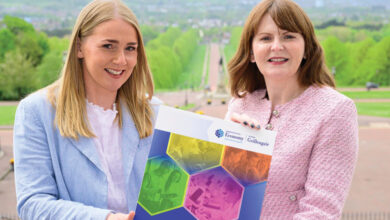PR: in the digital age
 John Evans, the founder of ATC Digital Communications, discussed the digital evolution of the PR industry at agendaNi’s new media seminar.
John Evans, the founder of ATC Digital Communications, discussed the digital evolution of the PR industry at agendaNi’s new media seminar.
When John Evans began his career in financial and corporate PR in 1997, he had just one computer in his office that could access dial-up internet. In his opinion it is digital that has saved PR, with the industry now worth £12 billion last year and investment increasing by 8.5 per cent per annum. The PR industry should technically be struggling with the challenging economic environment, the emergence of self-publicists, strong competition and fewer journalists. As Evans observed: “The industry has had to evolve and its had to evolve rapidly.”
It has been a challenge as content is moving into new formats and there is now a need to plan integrated campaigns across various platforms. Evans described digital media as a ‘new ecosystem’ to which PR needs to adapt. He added that “PR has had to become tech savvy.” Social media trends can provide content to target markets. He also remarked that “data is now the key to everything”. PR has had to evolve its communications strategies and target a new brand of online influencer, such as bloggers, academics and possibly even celebrities with huge online followings.
Evans stated that there is “so much more to digital media than just twitter.” He believes that digital provides more opportunities and more transparency. Companies can view the reach that their advertising has in detail and a return can be quantified on an investment. Digital now typically accounts for 50 per cent of a company’s marketing budget. Evans then examined the digital budget breakdown, with 47 per cent being spent on display and social adverts. Only 10 per cent of the digital budget is spent on social media. Surprisingly, Evans pointed out that 97 per cent of people who ‘liked’ a brand on facebook never revisit the page.
Digital works in real time, allowing strategy to constantly evolve with an ongoing contact with target audiences. He views content as “an investment and a commodity in a competitive market.” Creating content “on the fly” is important as audiences are busy, mobile and cynical. They suffer from information overload and text is rarely read, so content needs to be creative, interactive, accessible and sharable.
Evans remarked that “the press release is no longer” and content now needs to be evolved through a multimedia approach, particularly as 60 per cent of the UK population own smart phones and 25 per cent own tablets. He added that we need to ask: “How do our audiences consume information best?” Evans believes that video content is imperative: 4 billion YouTube videos are watched every day and 500 years of YouTube video are watched daily via Facebook.
Risks to online reputation need to be managed and monitored. Evans pointed out that many companies that he encounters have never googled themselves to find out what is being said about their brand online. Companies must assess their digital assets; for instance a good corporate website is vital as is understanding the social channels that are relevant to their business.
Digital media benefits companies through identification, reach and providing access to broader audiences. Evans contends that digital is not a matter for one person; it is a company mind set. It cannot be done without investment in training and technology. He also stressed the importance of PR and quoted Bill Gates: “If I was down to my last dollar, I’d spend it on public relations.” As for the future of the PR industry, Evans believes it is important to keep personal connection as much as is possible. However, he also predicts that PR must “adopt digital, hire digital, breathe digital.”





